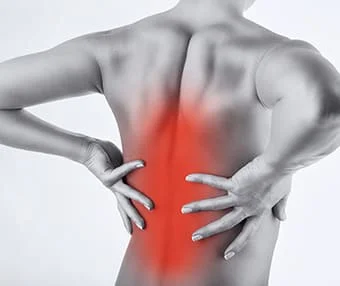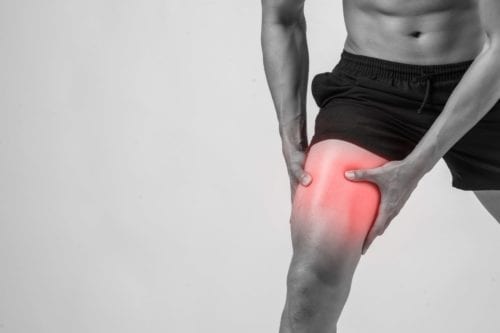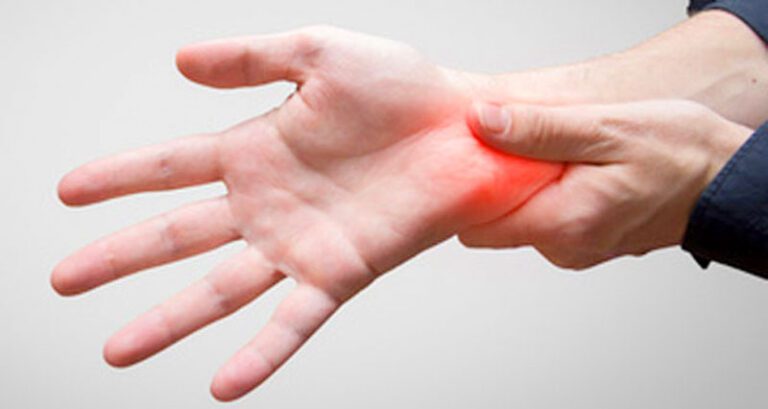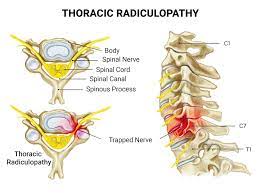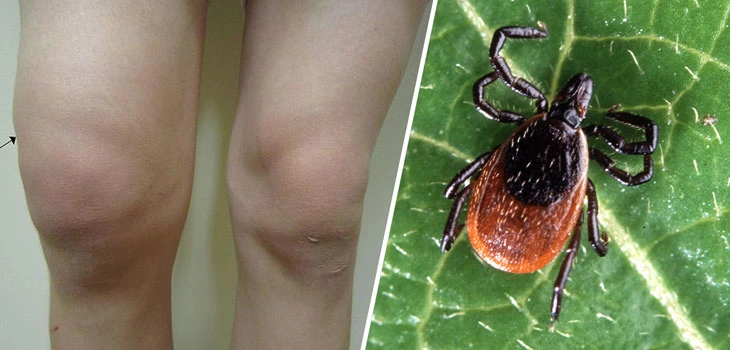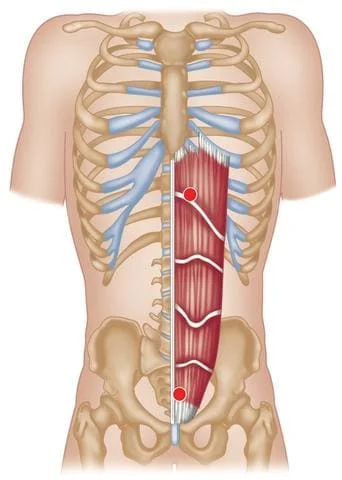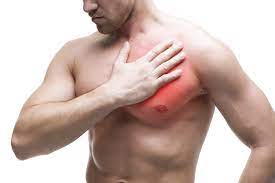Middle back muscle pain: Cause, Symptoms, Treatment, Exercise
When you feel sharp or stabbing pain below the neck & above the bottom of the rib cage, it is indicated to be muscle pain in the middle back.
You also feel tightness or stiffness in the muscle.
This muscle pain is produced due to many reasons like sprain & strain in a muscle, and injury in the muscle.
This muscle pain is mostly relieved by to RICE principle, pain medication & physiotherapy treatment.
Table of Contents
Which part of the back is considered your middle back?
- Your middle back is included in the thoracic spine which consists of 12 vertebrae.
- These all vertebrae are connected to the ribs & represent the rib cage area between the neck & the diaphragm.
- Thoracic Erector Spinae group muscles are around the thoracic spine.
- In the thoracic Erector Spinae group, muscles include Iliocostalis, Longissimus & Spinalis– the main extensor – backward bending muscle of the thoracic spine which is located on either side of the vertebral column.
- The erector spinae muscle is most massive in the lumbar & thoracic regions.
What are the causes of the middle back pain?
- Poor posture:
- If your posture is applied repeated pressure on the spine which is lead to middle back muscle pain.
- Because your muscles & ligaments in your back do the work hard to keep you balanced when you slouch.
- So that overworking of these muscles which is lead to aches & middle back pain.
- Obesity:
- Weight & lower back pain is a positive correlation between obesity & back pain.
- So When your weight increases, that risk of middle back pain.
- Muscle sprain or strain:
- Sprains mean the tearing & stretching of ligaments.
- Strains mean the tearing & stretching of muscles or tendons.
- When you are regularly lifting heavy objects, but within the proper form, it is lead to a sprain or strain of the middle back.
- Sprains & strains also occur after an awkward & sudden movement.
- Fall or another injury:
- This middle back muscle is less experience due to injury than the cervical spine & lumbar spine.
- These injuries include:
- A car accident
- Blunt force trauma
- Sports accident
- A hard fall like down the stairs & from a height
- A thoracic spine injury happens to anyone, but older people are at a higher risk.
- When you experience middle back pain after the incident so that contact your doctor immediately.
- Herniated disk:
- A herniated disk occurs when the inner gel-like core of a disk in your middle back pushes against the outer ring of cartilage, which is applied to putting pressure on a nerve.
- This condition is commonly called slipped disks or ruptured disks (Intervertebral disc prolapse).
- This pressure is produced nerve pain, tingling & numbness in the middle back muscle which also radiates to the nerve in the legs.
- Osteoarthritis:
- Osteoarthritis – OA is a degenerative joint disease that occurs when the cartilage covering your joints breaks down, which is causing bones to rub together.
- Aging:
- Older people are more experience with middle back pain.
- This middle back pain mostly occurs in 30 to 50-year-olds.
- Some age-related process which is naturally worn on the body, including thinning bones, a reduction of fluid between joints in the spine & reduction in muscle mass all things are produced middle back pain.
- Fractures:
- Vertebrae fractures often occur due to trauma like a fall, car accident & sports injury.
- These fractures also occur in people with a reduced bone density like people with OA.
- Fractures are produced to severe middle back muscle pain which is become worse during the movement.
- Due to the fracture, you are also experiencing incontinence, tingling & numbness this fracture is sometimes impacting the spinal cord.
- Kidney problems:
- Some kidney problems produce pain in the middle back which is stay under the rib-cage on either side of the spine.
- Lifestyle factors:
- When you do not exercise daily it leads to weak muscles, which is contributing to pain.
- If you do improper lifting it leads to middle back muscle pain.
- Osteoporosis:
- Osteoporosis this condition is a type of bone disease which is given to results in brittle bones.
- It occurs when the body does not make enough new bone to replace the natural bone loss.
- Mental health conditions:
- When you are experiencing depression & anxiety it tends to increase the risk of developing the middle back muscle pain.
- Scoliosis:
- Scoliosis means the spine curve becomes sideways which leads to uneven distribution of weight throughout the back & produces middle back pain.
- Tumor:
- If occur to a tumor is growing in the middle back, it may affect the spinal alignment which is applied to pressure on the near nerves, muscles & ligaments.
What are the symptoms of middle back muscle injury?
- You feel several different symptoms of middle back pain.
- Your symptoms depend on the cause of your muscle pain.
- You feel muscle aches & a dull type of pain.
- You also feel too sharp & stabbing pain.
- This type of pain is sometimes a burning sensation
- You are feeling tightness & stiffness in the muscle.
- Sometimes you feel tingling & numbness in the arms, legs, or chest.
- Also feeling of weakness in the legs or arms
- Sometimes loss of control of bowel or bladder.
- You feel trigger & tender points in the muscle pain.
- You are observed swellings & spasms around the muscle.
How to diagnose middle back pain?
- You must be contacted your doctor when the symptoms become too severe so that follow the diagnosis to try to know the causes of the middle back pain.
- The doctor is using the following steps for diagnosis:
- Physical exam:
- During the physical exam, the doctor observes your spine, head, pelvis, abdomen, arms & legs.
- When occurring in an accident as an emergency responder you put a collar around your neck during the examination to stabilize the spine.
- Testing:
- Your doctor is advised to some tests which are helpful to diagnose these tests including neurological & imaging tests.
- A neurological test examines the function of the brain & spinal cord.
- During the test, your doctor is you to wiggle your toes & fingers.
- This test indicates the status of the spinal cord & nerve endings.
- Imaging tests are produced to pictures of the inside of your body.
- These tests reveal fractures, bone degeneration & other causes of middle back muscle pain.
- The tests include:
- MRI scan
- X-ray
- CT scan
- ultrasound
- These imaging tests allow your body to any damage to your spine & determine an appropriate course of treatment.
What is the treatment for middle back muscle pain?
RICE principle:
When you feel pain in the middle back muscle doctor is advised to RICE principle as home treatment or primary treatment.
- R – rest = When you feel muscle pain doctor is advice to you rest for sometimes form activities for release to muscle pain.
- I- ice = You are applied to ice on the area of the pain for the 20 minutes, release to swellings & muscle pain but always applied to the ice with the help of a towel between the skin & ice to prevent ice burn, you can also be used to ice pack & frozen peas for ice therapy.
- C- compression = You can also apply compression bandage release to muscle pain & swelling.
- E- elevation = When you feel pain middle back you must be applied to the pillow under the leg to relieve the swellings & also take care in the sleeping position.
Pain medication :
- In many cases of muscle pain, the doctor prescribes anti-inflammatory & muscle relaxant drugs.
- When a doctor suspects this muscle pain is due to depression then the doctor is advised to an anti-depressant drug but not take it longer-term.
- An opioid is advised for severe pain but this drug is also not recommended for long periods – 7 to 10 days.
- You can also apply pain-relieving gel & spray like volini gel & spray on the area of muscle pain to release muscle pain & swellings.
What is Physiotherapy treatment for middle back muscle pain?
When the muscle pain is not relieved after the home treatment & pain medication then the doctor has advised physiotherapy treatment to release muscle pain.
Physiotherapy treatment is help you relieve pain, swelling, spam & tightness of the muscle pain.
The physiotherapy treatment includes massage, electrotherapy treatment & exercise therapy.
Massage:
- When the trigger & tender points are present in the muscle pain area therapist is advised to massage therapy release to the muscle pain.
- Massage is applied after 2 – 3 days of following the RICE principle when you feel to release of the pain.
- Massage is applied with the help of the oil & applied for 5 -10 minutes.
- Massage is applied 3 times per day at home.
Electrotherapy treatment:
After the RICE principle, pain medication & massage if the muscle pain is not relieved then used Electrotherapy treatment for released to muscle pain.
To relive the swellings, spams & pain therapist is advised to you electrotherapy treatment.
In electrotherapy, the treatment therapist is used to many machines.
- When the trigger & tender points are present therapists are advised & to apply US = ultrasound therapy for the release of muscle pain.
- This treatment is applied with the help of gel & applies for 5 to 10 minutes on the area of pain.
- This therapy helps you release pain & swelling.
- Reduce to pain therapist is applied to SWD = short wave diathermy, IFT = Interferential Therapy, TENS = Transcutaneous Electrical Nerve Stimulation on the area of pain.
- SWD = Short wave diathermy is hot therapy for release to spams on the area of pain.
- IFT = Interferential Therapy & TENS = Transcutaneous Electrical Nerve Stimulation is applied with the help of gel & electrodes on the area of pain.
- This therapy is applied for 10 minutes to the area of pain.
Exercise therapy for upper back muscles pain:
After following the RICE principle for the 2- 3 days at home & primary treatment & the help of pain medication, you feel released from the pain.
When you feel too comfortable & release from your muscle pain then the physiotherapist is advised to you exercise therapy reduce to muscle weakness & tightness.
The exercise therapy for muscle pain includes Stretching & strengthening Exercises.
Stretching exercise helps to relieve muscle tightness as well as strengthening Exercise is help you relieve muscle weakness.
Stretching exercise:
After the follow of Electrotherapy for 2-3 days for release to muscle pain by physiotherapist then the therapist is advised to stretch for release to muscle tightness.
This stretching is applied when your pain is released & when you feel comfortable.
- Cat-Cow
- Passive backbend
- Seated twist
- Cobra Pose
- Child’s pose
- Latissimus dorsi stretch
Cat-Cow:
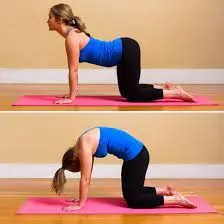
- Start this stretching on all fours with your wrists directly under your shoulder joint & knees under your hip joint.
- Feel to free for your knee joint on a blanket when you feel discomfort.
- Spread your fingers wide & distribute to weight evenly throughout your hand.
- Press your palms & finger pads into the ground to avoid dumping weight into the wrist.
- Then Inhale & gently send your pelvis upward your heart forward & dip your belly down & face up.
- Try to arch your back like a cat, rounding your spine.
- Try to tuck in your pelvis & let your head hang loose.
- Repeat this 3 times in 1 session & perform 3 sessions per day.
Passive backend:
- First roll up a blanket, towel, or yoga mat.
- Place the roll on the floor.
- When you use a yoga mat, you must want to roll only part of it, depending on your middle back flexibility & the mat’s thickness.
- A bigger role requires more flexibility & smaller one offers a more gentle release.
- You are lying on the roll so that it rests against the bottom of your shoulder blades, close to the middle of your back.
- When you use the yoga blocks for this backbend, place one block under your shoulder joint & a second block under your head.
- Then elevate your head as much as necessary so that your neck feels supported.
- Must stay relaxed in the posture & place a second blanket under your head like a pillow.
- Keep your breath long & deep.
- Repeat this exercise 3 times in 1 session & perform 3 sessions per day.
Seated twist:
- you are sitting cross-legged if possible or in a chair.
- I sit up tall & place my right hand behind you so that bringing your left hand to your right knee joint.
- Try to gently twist your heart to the right.
- Lengthen through the spine & feeling the twist wring out the tension in the middle of your back.
- Start attention to the heart area & feel the back open.
- Do not over-twist by pulling on your knee joint & twisting too aggressively.
- Try to gaze over your right shoulder joint only as far as your neck allows.
- Hold for 10 seconds & release to center.
- Repeat this exercise 3 times in 1 session & perform 3 sessions per day.
Cobra Pose:
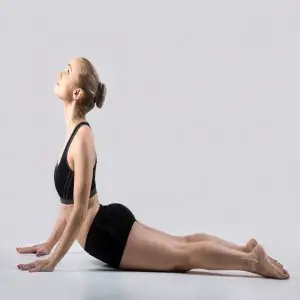
- You are lying on your stomach means a prone position, body long, chin on the mat, or face down.
- Place your hands underneath your shoulder joint.
- Try to curl your chest off the ground & engaging your middle back muscles.
- Then lift your hands off the ground for a moment & engaging through the middle back.
- Try to press lightly into your hands to deepen the stretch.
- Hold for 10 seconds & release to center.
- Repeat this exercise 3 times in 1 session & perform 3 sessions per day.
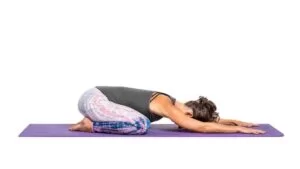
Child’s pose:
- you are starting in a kneeling position, with the hip joint & buttocks resting on the lower legs or feet.
- Spread the knee joint apart to a comfortable point.
- Fold the body forward & bringing the chest down towards the knee joint.
- If possible bring the forehead to the floor with the arms stretched out in front.
- The hands should be gently resting on the floor and must be keeping the arms straight.
- Hold for 10 breaths.
- Repeat this exercise 3 times in 1 session & perform 3 sessions per day.
Latissimus dorsi stretch:
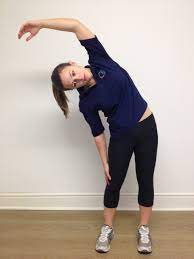
- You are in a standing or sitting position.
- Try to raise the right hand straight up, over the head.
- Bend the elbow joint, so that the right-hand drops toward the middle back.
- Must place the left hand on the right elbow joint & gently pull the right arm to the left.
- While pulling the right elbow joint & bend the body in a straight line to the left.
- Make sure not to lean forward-backward.
- Hold this stretching position for 10 seconds, then repeat on the other side.
- Repeat this exercise 3 times in 1 session & perform 3 sessions per day.
Strengthening Exercises:
After the follow of Electrotherapy & massage for 2 -3 days to release Neck muscle pain by the physiotherapist then the therapist is advised to you do strengthening exercises for Neck muscle weakness.
This strengthening exercise is always advised when you feel to release pain & when you feel comfortable.
This all strengthening exercise helps to you muscle weakness & pain.
- Bridge Pose
- Opposite arm/leg raise
- Passive backbend
- Resistance band pulls
- Dumbbell row
Bridge Pose:
- You are lying on your back, bend your knees & place your feet flat on the floor a few inches away from your tailbone.
- Your fingers can touch your heels.
- Press your shoulder joint into the floor & gently tuck them further to your middle back so that your chest puffs out slightly forward.
- Press into your feet & send your hip joint up to the sky.
- Clasp your hands underneath you, pressing into your arms and feet to lift your hips gently toward the ceiling.
- Bring awareness to your middle back behind your heart area & consciously send your chest toward the wall behind you.
- This pose helps to bring the backbend out of the middle back.
- Hold for 10 seconds before gently lowering down or unclasping the hands & bringing them to rest at your side.
- Repeat this exercise 10 times in 1 session & perform 3 sessions per day.
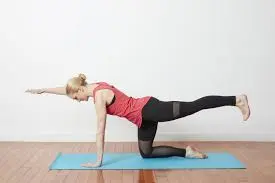
Opposite arm/leg raise:
- Try to on your hands and knee joints.
- Must keep your spine straight, with your hands directly below your shoulder joint & your knees aligned directly under your hips.
- Try to slowly reach out with one arm while extending the leg on its opposite side.
- Must be kept both straight levels.
- Hold for 10 breaths, then gently lower your arm & leg to starting position.
- Repeat this exercise 10 times in 1 session & perform 3 sessions per day.
Passive backend:
- First Place the roll on the floor.
- You are lying on the roll so that it is rest beneath the shoulder blades, near the middle of the back.
- Try to place something under your head if needs elevation.
- Start with arms away from the body & resting at a 45-degree angle.
- Hold this position for 1–2 minutes.
- Repeat this exercise 10 times in 1 session & perform 3 sessions per day.
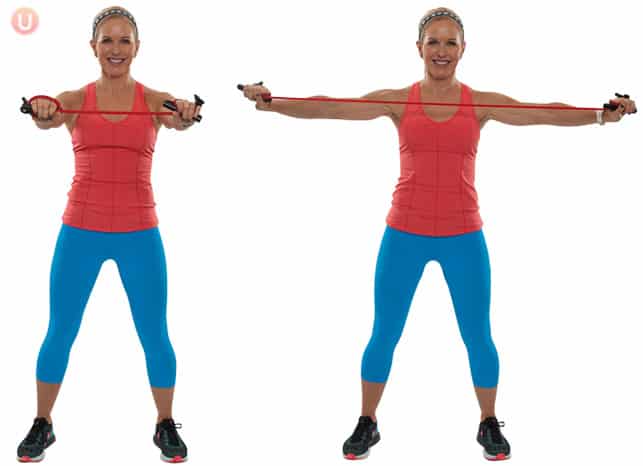
Resistance band pulls:
- You are standing with feet parallel & hip-distance apart.
- Then hold a resistance band & lift your arms out in front of you at shoulder joint height.
- Must be Keep your navel engaged & stand tall.
- Try to squeeze your shoulder blades together as your hands separate & slowly release them back to the center.
- Hold the exercise for 10 seconds.
- Repeat this exercise 10 times in 1 session & perform 3 sessions per day.
Dumbbell row:
- This exercise is completed on all fours & with the use of a bench or a chair.
- Start this exercise with a dumbbell in each hand.
- Try to engage your navel to keep your lower back supported.
- Slowly lift your elbow joint to bring the dumbbell in your right hand to your armpit.
- Must keep your arm hugged close to your body.
- When you are using a bench for this exercise, your left knee joint & hand stay on the bench.
- Your right leg stays on the ground as you row on the right side.
- Hold the exercise for 10 seconds.
- Repeat this exercise 10 times in 1 session & perform 3 sessions per day.
What is a surgical treatment for middle back muscle pain?
After the medical treatment & physiotherapy treatment pain is not relieved then the doctor is advised surgical treatment.
Surgery for middle back muscle pain is very rare.
Some possible surgeries for muscle pain include:
- Laminectomy = In this surgery removes the entire lamina & the back wall of a vertebra which decompresses the spinal cord.
- Laminotomy = In this procedure removes part of the lamina which alleviates a pinched nerve.
- Diskectomy = In this surgery removes part of a spinal disk which alleviates a pinched nerve.
What are home remedies for this middle back pain?
- You are applying it to ice the area & later apply it to heat.
- It is one of the most common methods which is provided immediate relief.
- You are taken to consider taking over-the-counter pain medication like ibuprofen (Advil) & naproxen (Aleve) to reduce the swelling & pain.
- Stretch & strengthen the middle back muscles by doing exercises like yoga.
- You must improve your posture release to middle back muscle pain.
- Use some steps include to :
- Must keep your shoulder joint back during the standing position.
- Avoid slouching posture.
- Take standing breaks if you sit for long periods.
- If you do a desk job must be adjusting your chair & computer monitor height, keyboard & mouse positioning which is provided to your good posture.
How to Prevent Middle Back Muscle Pain?
- You change your sleeping position in daily life because If you sleep on your back it is increased the risk of mis-aligning your spine which produces middle back pain.
- There are some positions described which are preventing you try this position:
- Try to sleep on your side with a pillow between your knee joint & sleeping in the fetal position.
- Try to adjust your posture:
- Maintain good posture which is to give your middle back muscles a break & allow them to strengthen.
- Your standing & sitting position must be straight for that lowering the chair height so that your feet stay flat on the ground then moving the computer screens at eye level & use a standing desk for all strategies to improve your posture.
- If you feel weakness in muscles then contact to physiotherapist which helps you for improving your core strength, posture, spinal mobility, & endurance.
- Always maintain a healthful weight because being overweight & obese puts extra stress on the middle back muscles.

